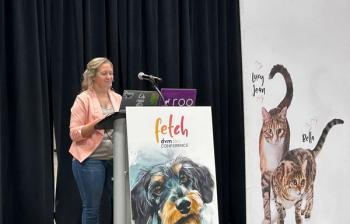
Staff empowerment (doctor leverage) increases veterinary practice success (Proceedings)
Veterinary practice success today is about relationships between the client and the veterinary practice team.
Veterinary practice success today is about relationships between the client and the veterinary practice team. The client wants a caring team of staff and doctors to take the time to do a detailed examination, diagnosis and treatment combined with getting an adequate history. The clients want the close relationship with the veterinary practice to build confidence that someone at the practice is caring for their pet. Yet the doctor must see 15 to 24 or more patients per day to generate the revenue to support the hospital overhead, including the high cost of the high tech equipment needed to maintain the high quality of medicine to meet the standard of care.
The benchmarks today for veterinarians show production needed at $400,000 to $500,000 per year per doctor. At 22% of production, this will generate $88,000 to $111,000 for doctor compensation. If the average patient charge is $150 per patient, the doctor will have to average 15 patients or more per day per year, including doing surgery, diagnosis and treatment. In most practices that means some days the doctors will see 30 patients and some days the doctor will see 10 patients. On the busy days the doctor will have to limit the contact time with the client and patients to 15 to 20 minutes maximum. In order to also complete the needed surgery, staff will have to assist seeing patients and answering clients' questions.
For the practice to be "high tech" and "high touch" or "high in caring", the increased contact time must come from our team support along with empathetic doctors. In order to continue to raise the standards of the hospital with "high tech" and its equipment requirements, the costs go up. The support staff must be able to comfort and build the client relationship while at the same time delivering high quality care and the perception of the same by the client. In the author's experience when the staff members can take a complete history before the doctor enters the examination room, the doctor can do the examination in 7 to 12 minutes and order the diagnostic tests and/or treatments and move to the next room.
To build the relationship and get client compliance, the staff person can explain the needed tests and/or treatment and answer most client questions.
To accomplish this, we must have more doctor leverage and more staff contact time with the client. This will require training of staff members and providing staff members with the tools (whether on paper or in the computer) so they can be consistent and thorough in communication with the client to get adequate history by body system and explain the needed care plan. The staff member taking the history will have a body system history taking sheet to discuss each system with the owner to confirm and question any abnormalities known by the owner. This history taking by the staff person will take up to 10 to 15 minutes.
After client compliance with recommended diagnostic tests and treatment is attained by the team member, there comes a time for the patient to be discharged. Here again the team members must be able and trained to deliver the go home instructions and medications to a level of client understanding and cooperation so the patient gets the proper care. The team member going over the treatment and go home instructions usually will spend 10 to 15 minutes with the client.
Now the client has spent 20 to 30 minutes with the staff person and only 7 to 12 minutes with the doctor. Yet upon client surveys, the client perceives they have spent 30 minutes plus with the doctor.
Of course, even though the client has no perception of the time needed for the staff members to draw body samples and run the tests, these procedures are also performed by the staff members completing the patient's cycle to total another 10 to 15 minutes at the least of contact with the patient by the staff person.
Therefore, the staff members have spent 30 to 45 minutes on each patient, while the doctor only spent the examination time of 7 to 12 minutes plus the review of tests time and client results presenting time of 10 to 12 minutes to add to a total doctor's time of 17 to 24 minutes, while the staff has spent 30 to 45 minutes with the patient, which is twice or more the amount of time the doctor has spent with the client and patient. All parties win, with leveraged doctors and properly trained and empowered team members. Clients will also perceive more relationship building and a higher quality of medicine.
Newsletter
From exam room tips to practice management insights, get trusted veterinary news delivered straight to your inbox—subscribe to dvm360.






